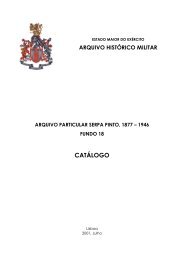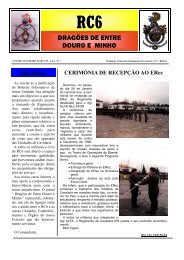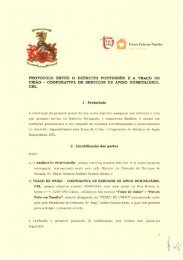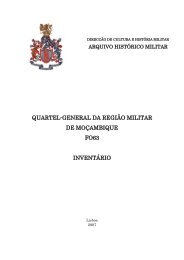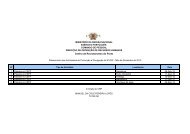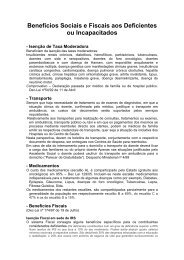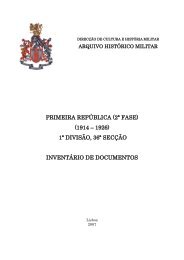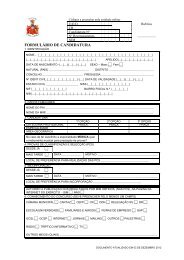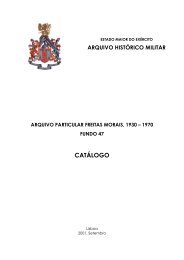Edição nº 195 - Exército
Edição nº 195 - Exército
Edição nº 195 - Exército
Create successful ePaper yourself
Turn your PDF publications into a flip-book with our unique Google optimized e-Paper software.
AZIMUTE <strong>195</strong> - 27<br />
Concepts and Capabilities Development Center and the<br />
Training Command; some were assumed by the Federal<br />
Office of Bundeswehr Materiel, Information Technology<br />
and Equipment Management, and the Bundeswehr Planning<br />
Office.<br />
The aim of reorganizing the Bundeswehr command and<br />
control structure is to cut the Gordian Knot, that means to end the<br />
armed service’s competition for resources by establishing the Planning<br />
Office where the allocation of scarce resources is tailored to<br />
all armed services and their capabilities and in line with the political<br />
requirements to ensure sustainable and financially feasible capability<br />
development.<br />
The framework conditions mentioned earlier resulted in this<br />
structure of the Army Concepts and Capabilities Development Center.<br />
It is designed for the holistic approach to Army development at<br />
one single stage to be achieved by taking into account the requirements<br />
of the 13 branches and the Special Forces. This design will<br />
help us to realize our goal in developing the “Army System” more<br />
effectively and efficiently. The demand on the Army Concepts and<br />
Capabilities Development Center is to focus its efforts on a holistic<br />
approach to Army development.<br />
New Army Structure “Heer 2011”<br />
Regarding the Infantry, the Army will comprise 5 Light Infantry<br />
Battalions, 3 Mountain Infantry Battalions and 2 Parachute Regiments<br />
and one caderised Light Infantry Battalion.<br />
In previous structures, the Light Infantry almost appeared<br />
like a rarity in an Army mainly consisting of armoured units. In the<br />
new structure, the Light Infantry, together with the Armoured Infantry,<br />
constitutes the core of the majority of contingents.<br />
The German Army in its future structure will be organised<br />
into three Division Headquarters with eight Brigades. The elements<br />
of the “Rapid Response Forces Division” are planned to fulfil specific<br />
tasks, e.g. within the framework of national crisis management,<br />
while the other two commands are composed of forces that are to<br />
sustain defined contingents of different nature and various sizes on<br />
operations all over the world over prolonged periods. The underlying<br />
scenarios are primarily stabilisation operations, but also rapid response<br />
operations of all intensities. Infantry-specific capabilities will be<br />
available in all 8 brigades.<br />
The various agencies will be merged into a Training<br />
Command including the remaining schools and training facilities plus<br />
a centralised Office for Conceptual Planning and Force Development.<br />
This office will combine major elements of the decentralised<br />
agencies that are currently located at the branch schools. All units in<br />
this basic structure are substantiated by the requirements evolving<br />
from the so-called Level of Ambition of specific contingents. It is a<br />
matter-of-course that a certain buffer is provided for to take account<br />
of the experiences regarding mission-ready personnel in the units<br />
and formations.<br />
Light Infantry Battalion<br />
This picture (see picture 1) depicts the structure of a German<br />
Light Infantry Battalion. Company Alpha comprises platoons<br />
providing combat service and command support. Companies Bravo,<br />
Charlie and Delta are Light Infantry Companies with three rifle platoons<br />
and one heavy weapons platoon each. The structure of the<br />
Armoured Infantry Battalions is similar, but they have neither a combat<br />
support company nor a support weapons platoon in the regular<br />
companies. The idea is, that in the armoured infantry the dismounted<br />
elements always have access to the firepower of their fighting vehicle<br />
and need therefore no additional support weapons.<br />
As already mentioned the three Light Infantry Companies in<br />
the battalion comprises three rifle platoons and one heavy weapons<br />
platoon. The heavy weapons platoon of each Company includes 3<br />
sniper teams, 3 Milan Anti-tank teams with guided missiles and 3<br />
teams with automatic grenade launchers. Every Company Commander<br />
has here the feasibility to concentrate his forces as the situation<br />
require. These sections are to complement the platoon’s capabilities<br />
on one side and enable them on the other side to concentrate on<br />
their core tasks especially in those cases, where vehicle-mounted<br />
weapons are not available or higher precision is required that cannot<br />
be delivered by heavy weapons systems.<br />
The fifth company features the battalion’s combat support<br />
assets. They include one subunit with 5 joint fire support teams (4<br />
Joint Fire Support Teams and 1 Joint Fire Support Coordination Team)<br />
whose capability for network enabled operations allows them to<br />
bring close air and fire support to bear. Equipped with Fennek they<br />
will be distributed to the companies. They are joined by one mortar<br />
platoon with 8 x 120mm mortars on Wolf (0, 75 to vehicle) and M113<br />
(able to engage enemy up to a range of 6350 m).<br />
Additional there are in the heavy company available: one<br />
platoon with Wiesel Weapon carrier (6x) to provide the antitank<br />
defence with their TOW antitank missiles (additional one machine<br />
gun each) and the direct fire support by one platoon Wiesel with<br />
machine cannon 20 mm (6x). The Battalion Commander is now able<br />
to form an antitank reserve, or he can for example protect open<br />
flanks…<br />
The commander can also shift the Wiesel to each company<br />
which is in the focus of the enemy attack.<br />
Supplementary the heavy company has the reconnaissance<br />
capacities at tactical level with one platoon Wiesel (6) with AOZ<br />
2000 (Autonomous Optronic Targeting System).<br />
In the Paratroopers Battalion we have: 4 Wiesel TOW in the<br />
antitank platoon instead of 6 and instead 6 Wiesel with machine<br />
cannons we have 3 platoons with 4 Wiesel = 12 MK Wiesel (that



